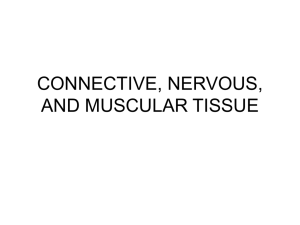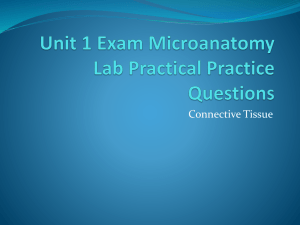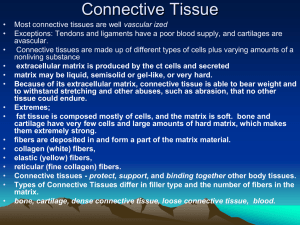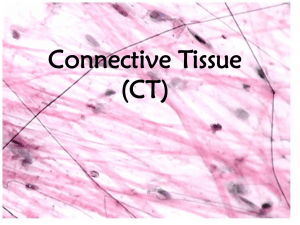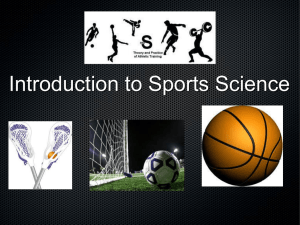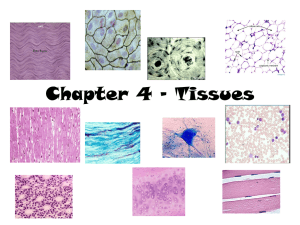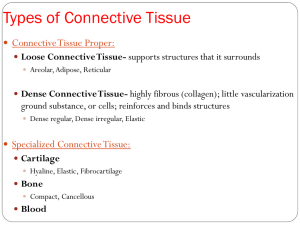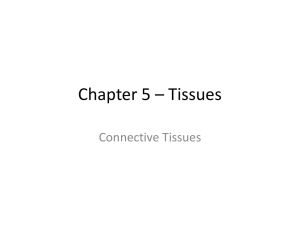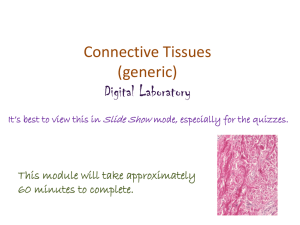ground substance
advertisement
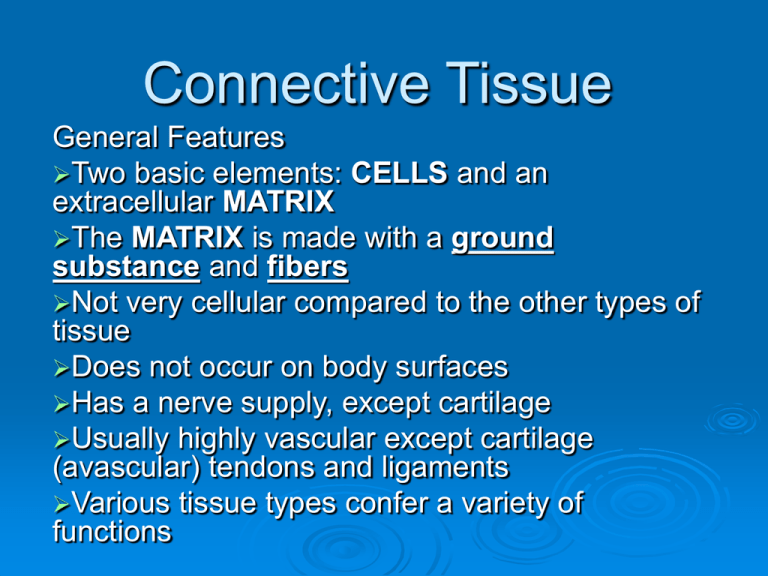
Connective Tissue General Features Two basic elements: CELLS and an extracellular MATRIX The MATRIX is made with a ground substance and fibers Not very cellular compared to the other types of tissue Does not occur on body surfaces Has a nerve supply, except cartilage Usually highly vascular except cartilage (avascular) tendons and ligaments Various tissue types confer a variety of functions Types of Connective Tissue Cells Fibroblasts- produce and secrete fibrous proteins and ground substance Macrophages- phagocytic cells that engulf and digest foreign particles Plasma Cells- produce antibodies Mast Cells- produce histamine, which dialates blood vessels, and heparin, an anticoagulant Adipocytes- store fat Erythrocytes- red blood cells, transport oxygen Leukocytes- white blood cells, several different types, function in immunity Thrombocytes- blood platelets, aid in blood clot formation Chondroblasts- produce and secrete fibers and ground substance in cartilage Chondrocytes- maintains the matrix of cartilage Osteoblasts- produce and secrete fibers and ground substance in bone Osteocytes- maintains the extracellular matrix of bone Connective Tissue Extracellular Matrix Ground substance can be Fluid Semifluid Gelatinous Hard Three Types of Fibers Collagen – strong, thick yet flexible Elastic – smaller in diameter than collagen, branch to form a network within the tissue, very elastic Reticular – also made with collagen, but much thinner than collagen fibers, provide support and strength and form the basement membrane Two Major Types of Connective Tissue Embryonic – found in the embryo and fetus Mature – present in newborns to adults Types of Mature Connective Tissue Loose Connective Tissue Dense Connective Tissue regular irregular elastic Cartilage areolar reticular adipose hyaline elastic fibrocartilage Bone Blood Lymph Loose Connective Tissue In Loose Connective Tissue, the fibers in the extracellular matrix are loosely arranged. Lots of ground substance. The ground substance in semifluid (viscous). Cells are scattered throughout the tissue. Not very cellular. Some cells reside permanently in the matrix; cells involved in immunity enter the matrix from blood and are transient. Loose Connective Tissue includes: Areolar Connective Tissue Adipose Tissue Reticular Connective Tissue Areolar Connective Tissue All three fibers (collagen, elastin and reticular) and several kinds of cells, including fibroblasts, adipocytes and cells of the immune system, are embedded in a semifluid ground substance Areolar is the most abundant type of connective tissue Found in the subcutaneous layer deep to skin, superficial part of dermis, mucus membranes, around blood vessels, nerves and body organs Function: supports glandular epithelium and mesothelial layers of mesentery, supports immune cells Areolar Connective Tissue Reticular Connective Tissue The dominant fiber is recticular fiber. Reticulocytes are fibroblasts that produce more reticular fiber than collagen. The ground substance is semifluid. Found in lymph nodes and other nonmuscular organs Provides a support structure for macrophages and other cells involved in immunity. Reticular Connective Tissue Adipose Tissue Contains fibers, fibroblasts and adipocytes embedded in a semifluid ground substance. Has a great number of adipocytes and very little matrix. Adipocytes can appear “empty” on slides. Surrounds organs, abundant in the greater omentum Function: provides storage for energy-rich lipids, cushioning and insulation for organs Adipose Tissue Dense Connective Tissue The extracellular matrix consists of tightly packed fibers that form bundles. Very little semi-fluid (viscous) ground substance. Fibroblasts are squeezed between the fiber bundles Three types of Dense CT Dense Regular CT Dense Irregular CT Dense Elastic CT Dense Regular Connective Tissue The extracellular matrix consists of tightly packed parallel bundles of collagen fibers with very little ground substance. Fibroblasts are squeezed between the collagen bundles Makes up tendons and ligaments Function: provides resistance to pulling forces while providing flexibility Dense Regular Connective Tissue Tendon Dense Irregular Connective Tissue The matrix has little ground substance and few fibroblasts. The matrix is packed with bundles of collagen fibers which are irregularly arranged (i.e. not in parallel to each other). Found in the dermis of the skin Function: Provides strength and support of organs Dense Irregular Connective Tissue Dense Elastic Connective Tissue Extracellular matrix is packed with elastic fibers, which mostly run parallel to each other, few fibroblasts and consists of very little ground substance. Found in the aorta Function: allows tissue to be stretched and then regain its original size and shape Elastic Connective Tissue in the Aorta Cartilage The extracellular matrix consists of collagen and elastic fibers embedded into a gelatinous ground substance. Chondroblasts secrete fibers and ground substance and become isolated in spaces called lacunae (little lakes or pools) and then transform into chodrocytes. Cartilage is avascular and receives nutrients through diffusion from adjacent vascular tissue Does not have a nerve supply Hyaline Cartilage Contains collagen fibers which are thin and not visible with a compound light microscope, where the matrix appears smooth and homogenous. Hyaline cartilage appears glassy to the eye. Chondrocytes are found in lacunae. The most abundant type of cartilage in the body. Found at the end of bones (articular), attaching ribs to the sternum (costal), in the nose (nasal) and in the trachea and bronchi. Function: provides support, reduces friction from moving bones, provides flexibility that allows movement without fracture Hyaline Cartilage Elastic Cartilage The matrix is packed mostly with elastic fibers. Chondrocytes are located in lacunae. Ground substance is gelatinous. Found in the external ear and epiglottis of the larynx Function: provides flexible support Elastic Cartilage Fibrocartilage Extracellular matrix is packed with thick collagen fibers. Has fewer lacunae and chrondrocytes than the other types of cartilage. Found in intervertebral discs and the menisci of the knees Function: provides cushioning and reduces friction Fibrocartilage Compact Bone The extracellular matrix consists of collagen fibers and a hard ground substance in which inorganic salts, mostly calcium and phosphorus salts, are deposited. Osteocytes are located in lacunae, much like the spaces in cartilage. Because the ground tissue is hard in bone and diffusion and osmosis is nearly impossible, little canals, or canaliculi serve as passages ways for nutrients and wastes as they connect the lacunae to larger canals that contain blood vessels. The matrix is organized and develops in layers called lamellae. The lamellae form concentric rings that make up a structure called an osteon. A single bone may have several hundreds and even thousands of osteons. In the center of each osteon is a large central canal, sometimes referred to as a Haversian Canal, which contains blood vessels and nerves Found in the skeleton of all vertebrates. Function: protects and provides support for body organs, provides levers to make movement possible, support for the body. Ground Compact Bone Blood The ground substance is a straw-colored fluid called plasma. Suspended in the plasma are erythrocytes, or red blood cells, leucocytes, or white blood cells, and thrombocytes, or platelets. Fibers are only present during clotting. Found in blood vessels throughout the body. Function: transports nutrients and vital molecules, wastes and molecular signals (hormones, etc.) throughout the body. Human Blood




